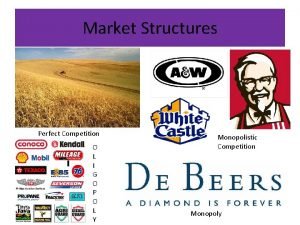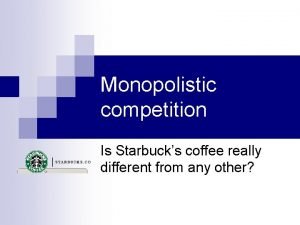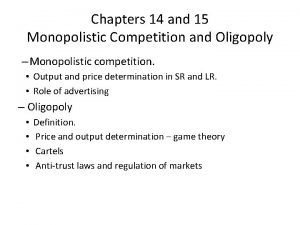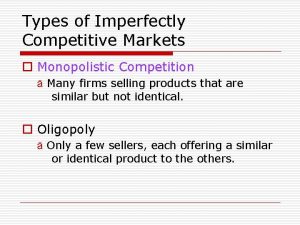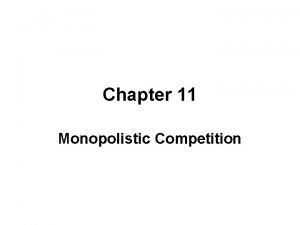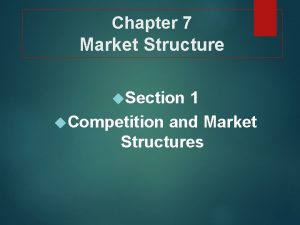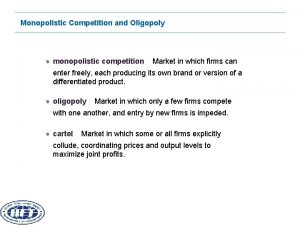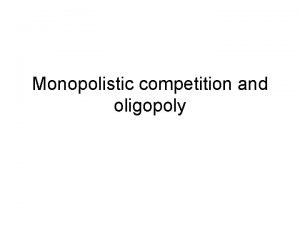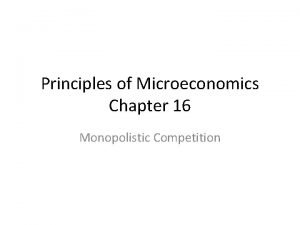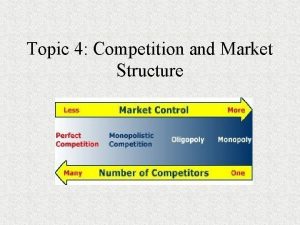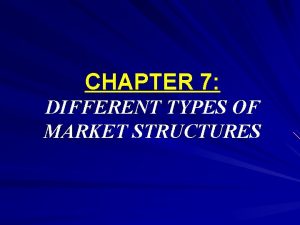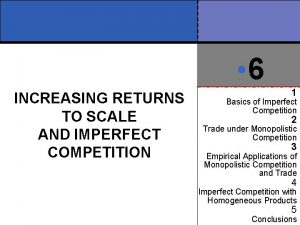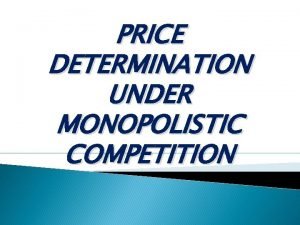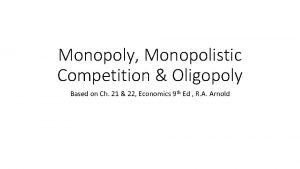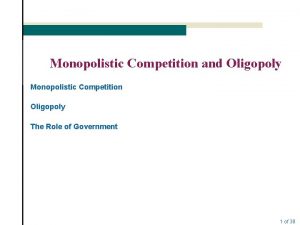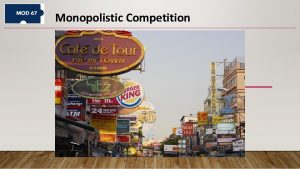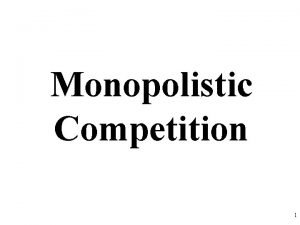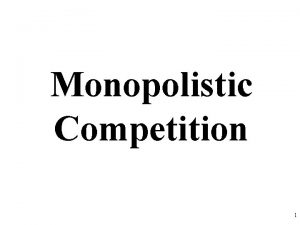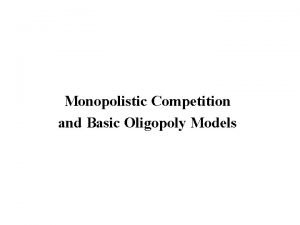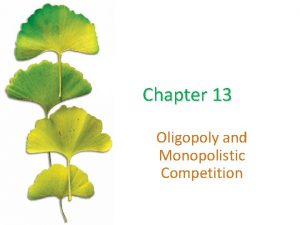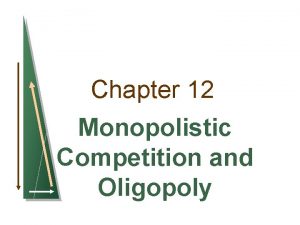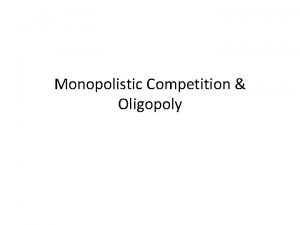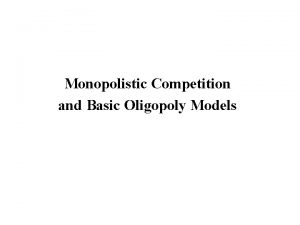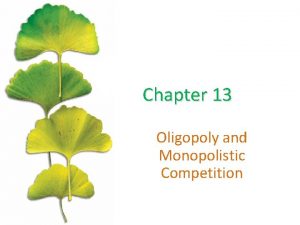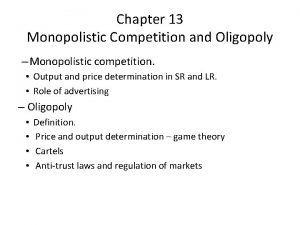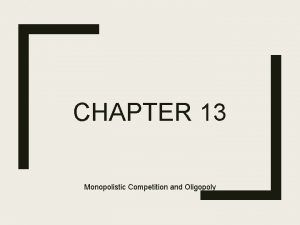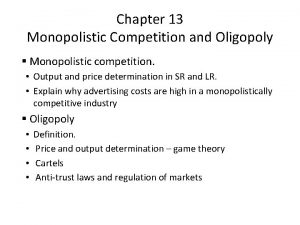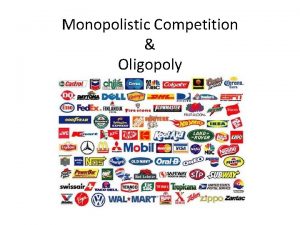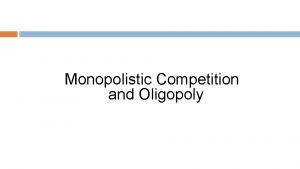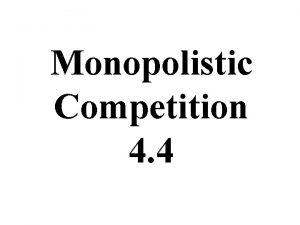Monopolistic Competition China Printer Market 1 Oligopoly 2




























- Slides: 28

Monopolistic Competition – China Printer Market 1

Oligopoly 2

Price pressures Competition creates down pressure POTENTIAL PERCEIVED VALUE Marketing communication can raise perceived value CONSUMER’S WILLINGNESS TO PAY Feasible price Consumer’s incentive to buy range PRICE Producer’s reward (contribution to fixed cost) VARIABLE COST 3

New-Product Pricing Strategies Two Broad Strategies • Market skimming pricing – set a high initial price • Market penetration pricing – set a low initial price

New-Product Pricing Strategies Market skimming pricing is a strategy with high initial prices to “skim” revenues layerby-layer from the market. – Product quality and image must support the price. – Buyers must want the product at the price. – The costs of producing a smaller volume cannot be so high that they cancel the advantage of higher prices. – Competitors should not be able to enter the market easily and undercut the high price.

New-Product Pricing Strategies Market penetration pricing sets a low initial price in order to penetrate the market quickly and deeply to attract a large number of buyers quickly to gain market share. – Price sensitive market – Production and distribution costs must fall as sales volume increases – Low prices must keep competition out of the market.

Product-Mix Pricing Strategies The firm looks for a set of prices that maximizes the profits on the total product mix. Five product mix pricing situations • Product line pricing – the products in the product line • Optional product pricing – optional or accessory products • Captive product pricing - complementary products • By-product pricing – by-products • Product bundle pricing – several products

Product-Mix Pricing Strategies Product line pricing takes into account the cost difference between products in the line, customer evaluation of their features, and competitors’ prices. – the price differences represent the perceived quality differences Normal Hair $3. 90 Anti-dandruff $4. 90 Hair Fall Defense $4. 90 Oily Hair $3. 90

Product-Mix Pricing Strategies Optional product pricing takes into account optional or accessory products along with the main product. – Decide which items to include in the base price and which to offer as options New car with ordinary rims $59, 000 New car with sports rims $60, 000

Product-Mix Pricing Strategies Captive product pricing involves products that must be used along with the main product. – Price the main, or driver product low and seek high margins on the supplies • For services: two-part pricing is where the price is broken into fixed fee and variable usage fee. – Decide how much to charge for the basic service and how much for the variable usage – The fixed amount should be low enough to induce usage of the service; profit can be made on the variable fees

Product-Mix Pricing Strategies By-product pricing refers to products with little or no value produced as a result of the main product. • Producers will seek little or no profit • Producers should accept any price that covers more than the cost to cover storage and delivery.

Product-Mix Pricing Strategies Product bundle pricing combines several products and offer the bundle at a reduced price. • Price bundling can promote the sales of products 1 bottle: $2. 70 Bundled 2 bottles: $4. 90

Price Adjustment Strategies Companies adjust basic prices to account for various customer differences and changing situations. • Discount and allowance pricing • Segmented pricing • Psychological pricing • Promotional pricing • Geographical pricing • Dynamic pricing • International pricing

Price Adjustment Strategies Discount and allowance pricing reduces prices to reward customer for certain responses such as paying early, volume purchases, and off-season buying. – Discounts • Cash discount for paying promptly • Quantity discount for buying in large volume • Functional (trade) discount for selling, storing, distribution, and record keeping – Allowances • Trade-in allowance for turning in an old item when buying a new one • Promotional allowance to reward dealers for participating in advertising or sales support programs

Price Adjustment Strategies Segmented pricing is used when a company sells a product at two or more prices even though the difference is not based on cost. • Adjust basic prices to allow for differences in customers, products, and locations • Airlines, hotels and restaurants – revenue management or yield management • To be effective: – Market must be segmentable – Segments must show different degrees of demand – Watching the market cannot exceed the extra revenue obtained from the price difference – Must be legal

Price Adjustment Strategies • Customer segment pricing is when different customer pay for different prices for the same product or service. • Product form segment pricing is when different versions of the product are priced differently but not according to differences in cost. • Location pricing is when the product is sold in different geographic areas and priced differently in those areas even though the cost is the same. • Time pricing is when a firm varies its prices by the season, the month, the day, and even the hour.

Price Adjustment Strategies Psychological pricing occurs when sellers consider the psychology of prices and not simply the economics. – Reference prices are prices that buyers carry in their minds and refer to when looking at a given product. – Noting current prices – Remembering past prices – Assessing the buying situations 9 $2 9 9.

Price Adjustment Strategies Promotional pricing is when prices are temporarily priced below list price or cost to increase demand. – Loss leaders – Special event pricing – Cash rebates – Low interest financing – Longer warrantees – Free maintenance • Risks of promotional pricing – Used too frequently – Copies by competitors can create “deal-prone” customers who will wait for promotions and avoid buying at regular price. – Creates price wars.

Price Adjustment Strategies Promotional Pricing • Loss leaders are products sold below cost to attract customers in the hope they will buy other items at normal markups. • Special event pricing is used to attract customers during certain seasons or periods. • Cash rebates are given to consumers who buy products within a specified time. • Low interest financing, longer warrantees, and free maintenance lower the consumer’s “total price. ”

Price Adjustment Strategies Geographical pricing is used for customers in different parts of the country or the world. – FOB pricing – Uniformed delivery pricing – Zone pricing – Basing point pricing – Freight absorption pricing

Price Adjustment Strategies • FOB (free on board) pricing means that the goods are placed free on board a carrier. At that point the title and responsibility passes to the customer, who pays the freight from the factory to the destination. • Uniformed delivery pricing means the company charges the same price plus freight to all customers, regardless of location. • Zone pricing means that the company sets up two or more zones where customers within a given zone pay a single total price. • Basing point pricing means that a seller selects a given city as “basing point” and charges all customers the freight cost associated from that city to the customer location regardless of the city from which the goods are actually shipped. • Freight absorption pricing means that the seller absorbs all or part of the actual freight charge as an incentive to attract business in competitive markets.


Price Adjustment Strategies • Dynamic pricing is when prices are adjusted continually to meet the characteristics and needs of the individual customer and situations. • International pricing is when prices are set in a specific country based on country-specific factors. – Economic conditions – Competitive conditions – Laws and regulations – Infrastructure – Company marketing objectives

Business Marketing Channels

Channel Behavior and Organization A multichannel distribution system

Traditional Communication Model 8 -26

Updated Communications Model • Consumers are now proactive in communications process – VCRs, DVRs, video-on-demand, pay-per-view TV, Caller ID, Internet 8 -27

Video: Motorola This case helps you understand IMC http: //www. prenhall. com/kotlervideo/12 e/index. html • How did Ogilvy & Mather apply the concepts of IMC to build Motorola’s communication strategy? What was the goal of the campaign that resulted? • What promotion tools have been incorporated in Motorola’s IMC campaign? 8 -28
 Monopoly vs oligopoly
Monopoly vs oligopoly Fast food oligopoly or monopolistic competition
Fast food oligopoly or monopolistic competition Is starbucks a perfect competition
Is starbucks a perfect competition Chapter 7 section 3 monopolistic competition and oligopoly
Chapter 7 section 3 monopolistic competition and oligopoly Monopoly vs monopolistic competition
Monopoly vs monopolistic competition Market structures venn diagram
Market structures venn diagram Perfect competition vs monopolistic competition
Perfect competition vs monopolistic competition Lump sum subsidy
Lump sum subsidy Continuous feed laser printer
Continuous feed laser printer Examples of oligopoly competition
Examples of oligopoly competition Non price competition in oligopoly
Non price competition in oligopoly Free entry and exit
Free entry and exit Feature of monopoly
Feature of monopoly What is a monopolistic competition example
What is a monopolistic competition example Monopolistic competition price
Monopolistic competition price Monopolistic competition example
Monopolistic competition example Monopolistic competition in long run
Monopolistic competition in long run Chapter 16 monopolistic competition
Chapter 16 monopolistic competition Monopolistic competition short run
Monopolistic competition short run Monopolistic competition def
Monopolistic competition def Monopolistic competition characteristics
Monopolistic competition characteristics Monopolistic competition companies examples
Monopolistic competition companies examples Oligopoly characteristics
Oligopoly characteristics Monopolistic competition
Monopolistic competition Price determination under monopoly
Price determination under monopoly Consumer surplus in a monopoly
Consumer surplus in a monopoly Consumer surplus in monopolistic competition
Consumer surplus in monopolistic competition Price determination under monopolistic competition
Price determination under monopolistic competition Excess capacity graph
Excess capacity graph
